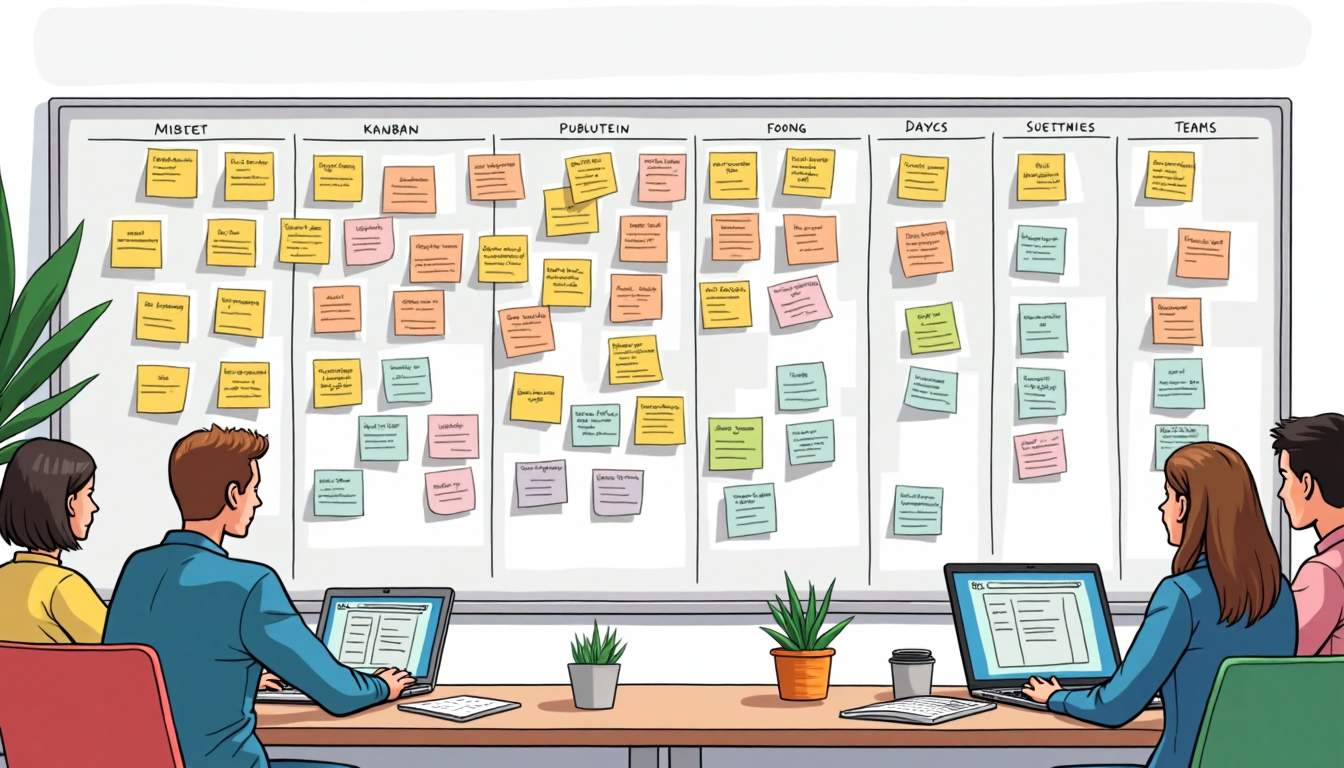Agile Development Team Staffing Strategies
In today’s fast-paced software development landscape, Agile methodologies have become the cornerstone of delivering high-quality products efficiently. However, the success of Agile largely depends on how well teams are staffed and managed. Building the right team with the right skills and mindset is crucial to harnessing the full potential of Agile practices. This article explores effective staffing strategies for Agile development teams, covering everything from team composition to remote management and continuous improvement.
Staffing for Agile Development Methodology
Staffing for Agile development requires a shift from traditional role-based hiring to a more dynamic, flexible approach. Unlike the waterfall model, where roles are often siloed and strictly defined, Agile emphasizes collaboration, adaptability, and cross-functionality. This means that when staffing an Agile team, organizations should prioritize individuals who demonstrate not only technical skills but also strong communication, problem-solving abilities, and a willingness to embrace change.
One key aspect is balancing technical expertise with soft skills. Agile teams thrive when members can effectively collaborate, provide constructive feedback, and adapt to evolving project requirements. According to the 15th State of Agile Report by Digital.ai, 58% of respondents cited team collaboration as a top factor in Agile success, underscoring the importance of interpersonal skills in staffing decisions.
Moreover, Agile staffing should consider team size and diversity. Scrum, one of the most popular Agile frameworks, recommends teams of 5 to 9 members to maintain effective communication and decision-making. Diverse teams, including varied backgrounds and perspectives, have been shown to foster innovation and better problem-solving, which aligns perfectly with Agile’s iterative and experimental nature.
In addition to team composition, organizations should also focus on creating a culture that supports Agile principles. This involves not only hiring the right talent but also providing ongoing training and development opportunities. Continuous learning is a cornerstone of Agile methodology, and teams should be encouraged to pursue certifications, attend workshops, and engage in knowledge-sharing sessions. By investing in their employees' growth, organizations can cultivate a workforce that is not only skilled but also deeply committed to the Agile process.
Furthermore, the role of leadership in Agile staffing cannot be overstated. Leaders should embody Agile values and practices, acting as facilitators rather than traditional managers. This shift encourages team members to take ownership of their work and fosters an environment where experimentation is welcomed, and failure is viewed as a learning opportunity. Agile leaders must also be adept at recognizing and nurturing talent within their teams, ensuring that individuals are placed in roles that align with their strengths and interests, ultimately leading to higher engagement and productivity.
Building Cross-Functional Agile Teams
Cross-functional teams are the backbone of Agile development. These teams bring together members with different skill sets—such as developers, testers, designers, and business analysts—to work collaboratively throughout the project lifecycle. This integration eliminates handoffs and delays common in traditional development models, enabling faster delivery and higher quality.
When building cross-functional Agile teams, it’s essential to identify the core competencies needed for the product and ensure each team member can contribute to multiple areas if necessary. For instance, developers with testing skills or designers with a basic understanding of coding can help smooth workflows and reduce bottlenecks. This versatility enhances team resilience and responsiveness to change.
Additionally, fostering a culture of shared ownership and accountability is critical. Cross-functional teams should be empowered to make decisions collectively, which requires trust and transparency. Regular Agile ceremonies like daily stand-ups, sprint planning, and retrospectives help reinforce this collaborative spirit and ensure alignment on goals and priorities.
Moreover, the dynamics within cross-functional teams can significantly influence their effectiveness. Team members should be encouraged to share their expertise and learn from one another, creating an environment where knowledge transfer is seamless. This can be further supported by implementing pair programming or collaborative design sessions, which not only enhance skill sets but also strengthen interpersonal relationships among team members. As a result, teams become more cohesive and better equipped to tackle challenges that arise during the development process.
Another important aspect to consider is the role of leadership in nurturing cross-functional teams. Agile leaders must adopt a servant leadership approach, prioritizing the needs of the team and facilitating their growth. This involves providing the necessary resources, removing impediments, and fostering an atmosphere where experimentation and innovation are encouraged. By empowering team members to take ownership of their work and supporting their professional development, leaders can cultivate a motivated and high-performing team capable of delivering exceptional results.
Scrum Master and Product Owner Staffing
Two pivotal roles in Agile teams are the Scrum Master and Product Owner, each serving distinct but complementary functions. Staffing these roles effectively can make or break the Agile process.
The Scrum Master acts as a facilitator and servant leader, ensuring the team adheres to Agile principles and practices. When staffing a Scrum Master, organizations should look for individuals with strong coaching skills, conflict resolution abilities, and a deep understanding of Agile frameworks. The Scrum Master must be adept at removing impediments and fostering continuous improvement without micromanaging the team. This role often requires a blend of soft skills, such as empathy and active listening, to create an environment where team members feel safe to express concerns and share ideas. Additionally, a successful Scrum Master should be proficient in various Agile methodologies, such as Kanban or Lean, to adapt the team's approach based on specific project needs.
On the other hand, the Product Owner represents the customer and business interests, managing the product backlog and prioritizing features based on value and feedback. Effective Product Owners possess a clear vision, excellent communication skills, and the ability to balance stakeholder demands with technical feasibility. Staffing this role often requires a blend of business acumen and technical understanding to bridge the gap between development teams and end-users. Furthermore, a strong Product Owner should be skilled in stakeholder engagement, capable of translating complex technical concepts into easily digestible information for non-technical stakeholders. This ensures that everyone involved has a shared understanding of the product goals and can contribute to its success.
It’s also important to recognize that these roles require ongoing training and support. Agile is a journey, and both Scrum Masters and Product Owners benefit from continuous learning and adaptation to evolving team dynamics and project complexities. Organizations should consider investing in professional development opportunities, such as workshops, certifications, and mentorship programs, to enhance the skills of their Scrum Masters and Product Owners. This commitment to growth not only empowers these individuals but also fosters a culture of agility within the organization, leading to improved collaboration and innovation across teams.
Moreover, the integration of tools and technology can significantly enhance the effectiveness of both roles. For instance, utilizing project management software can help Scrum Masters track team progress and identify bottlenecks, while Product Owners can leverage analytics tools to gain insights into user behavior and preferences. By embracing these resources, organizations can streamline workflows and make data-driven decisions that align with their strategic objectives, ultimately leading to a more successful Agile implementation.
Remote Agile Team Management
The rise of remote work has introduced new challenges and opportunities for Agile team staffing and management. Distributed teams can access a broader talent pool and offer greater flexibility, but they also face obstacles in communication, collaboration, and maintaining Agile rituals.
Successful remote Agile teams rely heavily on clear communication channels and robust digital tools. Video conferencing, instant messaging, and project management platforms like Jira or Trello are essential to replicate the in-person Agile experience. When staffing remote teams, it’s crucial to select individuals who are self-motivated, disciplined, and comfortable with virtual collaboration.
Time zone differences must also be carefully managed. While some overlap is necessary for synchronous meetings, asynchronous communication strategies can help maintain productivity without causing burnout. Additionally, remote Scrum Masters play a vital role in facilitating engagement and ensuring that team members remain connected despite physical distances.
Organizations that invest in building a strong remote Agile culture—emphasizing trust, transparency, and continuous feedback—tend to see higher team morale and better project outcomes. This culture is supported by regular virtual retrospectives and informal check-ins that help maintain team cohesion.
Agile Metrics and Performance Tracking
Measuring the performance of Agile teams is essential for continuous improvement and delivering value. However, traditional metrics like lines of code or hours worked don’t align well with Agile principles. Instead, organizations should focus on metrics that reflect team health, delivery speed, and customer satisfaction.
Common Agile metrics include velocity, which measures the amount of work completed in a sprint; cycle time, indicating how long it takes to complete a task; and lead time, the duration from feature request to deployment. These metrics provide insights into team efficiency and help identify bottlenecks.
Beyond quantitative data, qualitative feedback from retrospectives and stakeholder reviews is equally important. Combining both types of information gives a holistic view of team performance, enabling targeted interventions. For example, if velocity is consistent but customer satisfaction is low, the team may need to improve backlog prioritization or quality assurance processes.
It’s also critical to avoid using metrics punitively. Agile metrics should serve as tools for empowerment and learning rather than micromanagement. Transparent sharing of metrics fosters trust and encourages teams to take ownership of their progress.
Continuous Improvement in Agile Staffing
Agile is inherently about continuous improvement, and this philosophy extends to staffing strategies as well. Organizations should regularly evaluate team composition, skills, and dynamics to ensure alignment with evolving project needs and market conditions.
One effective approach is to conduct periodic skills assessments and gap analyses. This helps identify areas where additional training or new hires are needed. Encouraging team members to pursue certifications or workshops in Agile practices can also enhance overall team capability.
Moreover, staffing should be flexible to accommodate changes such as scaling teams up or down, integrating new technologies, or shifting project priorities. Agile staffing models often include a mix of permanent employees and contractors or consultants who can be brought in as needed.
Finally, fostering a culture of feedback and open communication supports continuous staffing improvement. Regular one-on-one meetings, 360-degree reviews, and anonymous surveys can surface insights about team morale, workload balance, and leadership effectiveness. By embracing these feedback loops, organizations can adapt their staffing strategies to build stronger, more resilient Agile teams over time.






